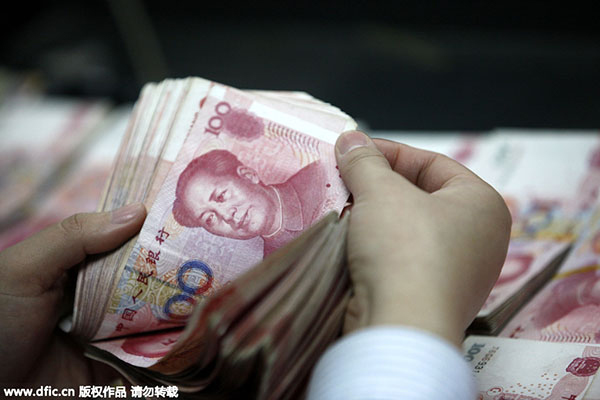 |
|
A Chinese clerk counts yuan banknotes at a bank in Huaibei city, East China's Anhui province, Jan 22, 2015.[Photo/IC] |
Large trade surplus and strong foreign direct investment are positive factors, official says
There is no reason to worry about a long-term depreciation of the renminbi, a senior official said on Thursday, after the central bank lowered the daily fixed exchange rate to a four-year low of 6.4236 yuan per US dollar.
Wang Yungui, head of the State Administration of Foreign Exchange's policy and regulation department, believes that the country's strong balance of payments position-reflected by a large trade surplus and stable foreign direct investment-will prevent a sharp fall in the currency.
Depreciation pressure on the renminbi, however, might have accelerated capital outflows since November, Wang said. Last month, foreign exchange reserves dropped by $87.2 billion to $3.44 trillion, the lowest level since February 2013.
"That decline in reserves can be tolerated, as well as the amount and speed of recent cross-border capital outflows," he said.
Wang said China is studying financial tools, such as a "Tobin tax"-a currency transaction tax on cross-border capital-to limit outflows. Such a measure could be applied in the future to curb potential risks when the market is further opened.
The current depreciation pressure on the renminbi originates in part from market expectations of an increase in the US Federal Reserve interest rate, combined with slowing economic growth momentum in China.
The renminbi's onshore spot rate, which was limited to a maximum 2 percent move up or down around the reference rate, extended a five-day drop, reaching 6.4433 yuan per dollar by noon on Thursday, the lowest level since Aug 13 when the People's Bank of China announced it would switch to a new exchange rate regime based on the currency's real supply and demand in the market.
The yuan-to-dollar daily reference rate dropped to 6.4140 on Wednesday-the lowest level since August 2011-influenced by the selling pressure in both onshore and offshore markets.
It has depreciated about 0.42 percent since it was included in the International Monetary Fund's Special Drawing Rights basket on Nov 30.
The move made it one of the world's five reserve currencies after it was designated "freely usable".
Wang Ju, a senior Asian Foreign Exchange strategist at HSBC Holdings, said, "We believe the People's Bank of China has been more 'hands-off' after the Special Drawing Rights announcement. This is in line with its commitment to a more liberalized foreign exchange regime."
The central bank's Vice-Governor Yi Gang said at a news conference after the Special Drawing Rights announcement that the stated goal of a "free floating" currency, without government intervention, indicated that the foreign exchange regulator may gradually tolerate higher exchange rate volatility.
Market observers, however, believe the downward pressure on the renminbi is not over yet, considering the approaching rate hike from the US Fed.
The rise of the Fed rate will lift the US dollar's value, and increase depreciation pressure on renminbi.
